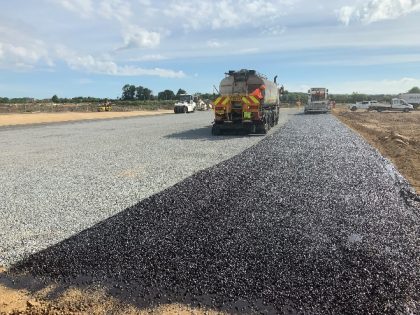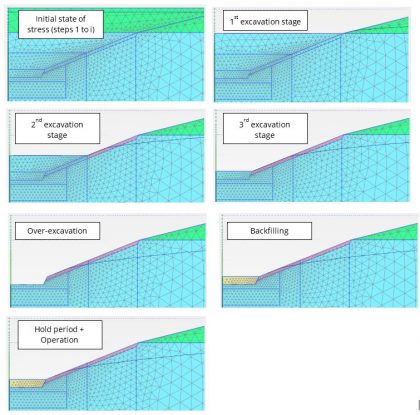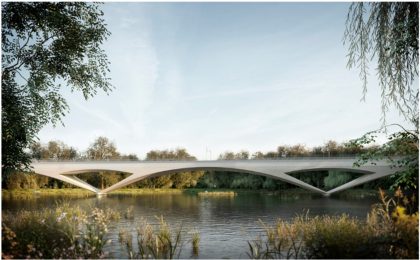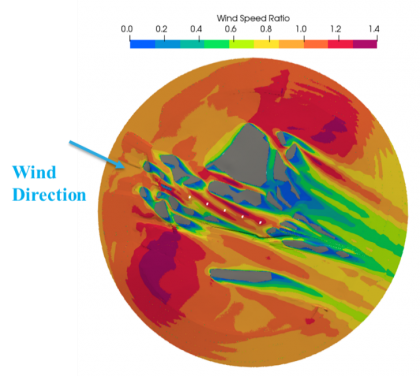Civil Engineering
Design, construction, and maintenance of the physical and naturally built environment such as roads, bridges, canals, dams, and buildings
Civil Engineering Resources
Resources include papers, videos, research summaries and good practice documents produced by authors from across the HS2 Family to capture learning, good practice and innovation from the HS2 programme
-
Published on
Benefits of steel-concrete bridges with double composite action
The paper aims to discuss the advantages and disadvantages of the double composite section in high-speed railway bridges from the design, construction and maintenance point of view. The paper is centred around the differences between single and double composite sections. Steel composite construction has been extensively adopted in the last 60 years for small to…
-
Published on
Shaft friction design for piles in extremely weak to weak Mercia Mudstone
There is limited guidance for pile design in the Mercia Mudstone, when it varies between a weathered stiff clay and unweathered weak mudstone. In this transitionary zone, it is common for the mudstone to be found interbedded with varying degrees of weathering over a significant depth, or for the material to gradually transition from a…
-
Published on
Test pile design, construction and testing – maximising the benefits of preliminary pile test results in pile design and construction at Euston Approaches
A 450m long retained excavation to a maximum depth of 18m close to sensitive 3rd party assets will be constructed to house future HS2 tracks north of Euston station. Approximately 1700 bored piles between 1.2 to 1.8m in diameter, with over 700 located beneath the base slab and founded primarily in the Thanet Sand Formation,…
-
Published on
Railway drainage design in constrained environments. A case study in the vicinity of HS2 Birmingham Interchange Station
The HS2 Birmingham Interchange Station has been located to provide connections to multiple transport modes and routes. It is surrounded by major roads and situated close to Birmingham Airport and the existing Network Rail Birmingham International Station. Given its proximity to new and existing infrastructure, the design of the drainage for the catchment areas around…
-
Published on
Colne Valley Viaduct foundation design
The proposed 3.4km long Colne Valley Viaduct provides an excellent opportunity to review and optimise design methodologies for large diameter bored piles within Chalk. Whilst piles have been successfully designed and constructed in chalk for many decades, the HS2 Colne Valley Viaduct will be required to support the highest speeds and dynamic forces of any…
-
Published on
Mitigating the effects of tunnelling under Euston Bridge 7
HS2 tunnels will pass below an existing main line railway intersection bridge near Euston, known as Bridge 7, constructed in the early 20th century. An assessment of tunnelling induced ground movement predicted potential adverse effects on the fragile historic structure. The challenge for the bridge mitigation team was to develop a methodology for logistics, design,…
-
Published on
Streamlining utilities ground movement assessments
Ground Movement Assessments (GMAs) involve analysing and mitigating the damage caused by construction related ground movement on strategic utilities, operational tunnels and historically important buildings. Gaining approval from owners of assets located in the densely populated areas around the HS2 Euston Station site, prior to construction works commencing, was therefore integral to the success of…
-
Published on
Aerodynamic design of HS2 tunnels
The aerodynamic design of HS2 tunnels has been achieved through balancing the civils design with the specification of the required aerodynamic characteristics of the rolling stock, resulting in smaller, more economic tunnel cross-sectional areas than would be provided in other countries for the same line speeds. Issues considered include aural comfort and safety for passengers…
-
Published on
Design of shafts and tunnels to decouple the construction programme
High Speed Two (HS2) Phase One includes the design and construction of six ventilation shafts in Lot S1 (Canterbury Works and Adelaide Road vent shafts) and in Lot S2 (South Ruislip, Mandeville Road, Greenpark Way and Westgate vent shafts). The Scheme Design started with a value engineering exercise; Two key drivers were to minimise disruption…
-
Published on
Train fire spalling risk assessment
Structural fire protection is provided to structures where necesssary to ensure the resilience of the structure in the event of a fire. Loss of material strength at high temperature and spalling of concrete can lead to structural damage and collapse if not adequately mitigated. However, provision of structural fire protection can add significant cost and…
-
Published on
Shallow TBM launch of the Northolt Tunnel West TBMs at West Ruislip
Launching tunnel boring machines (TBMs) from a station box or launch shaft is a delicate operation that requires careful planning to maintain safety. Seven TBMs excavate the tunnels on HS2 Phase Onethe southern section of the High Speed Two (HS2) Phase One route Lots S1 and S2 tunnels and will bore an approximately 23km twin…
-
Published on
The slowest part of HS2 – The design of HS2 automated people mover
The HS2 Automated People Mover (APM) provides the link between the new Interchange Station and existing local infrastructure of the NEC, Birmingham International Railway Station and Birmingham Airport. The system therefore provides a key piece of the connectivity of HS2 to the region. Located on an elevated viaduct, the APM is also unique amongst the…
-
Published on
Temporary access road optioneering and cost analysis
High Speed Two (HS2) Lots C2 and C3 covers a section approximately 80km long between the Chilterns and Warwickshire. To enable construction of these sections, it was identified that a temporary service road would be required along the length of the HS2 route. An optioneering study was commissioned aiming to reduce construction costs of this…
-
Published on
Reducing the impact of diverting a 42-inch water main
High Speed Two (HS2) intersects utility company networks throughout its length. Utility works are an important factor when planning and carrying out infrastructure projects, and similar diversionary works are likely to be required during Phase Two of HS2. This paper seeks to share examples of good practice and lessons learnt in the design and construction…
-
Published on
Ground Heave in Deep Cuttings: Evolution From Generic to Specific Models to Enable Refinement of a Risk Management Strategy
The route of the UK’s High Speed Rail network traverses the hilly terrain of the south midlands of England on a low, flat, straight alignment. Creating this alignment requires the formation of deep excavations through hills and ridges formed from the local geology which includes argillaceous (clay) strata. The process of excavation removes significant weight…
-
Published on
Bridging the gap between drainage design and BIM modelling
The design of the civil engineering works in High Speed Two (HS2) is a good example of what can be achieved when the Building Information Modelling (BIM) process is embraced. Central to the BIM process is a three-dimensional (3D) model that communicates the civil design to enable construction, asset management, operation and maintenance in a…
-
Published on
Development of the Streethay Cutting Design: From Retained to Open Cut
Streethay Cutting is a 2.5km long cutting that lies approximately 1km to the east of Lichfield, Staffordshire. It is at the northern part of HS2 Phase One, beyond which the route continues north to Curborough where the route splits: the mainline interfaces with Phase Two; and a spur connects to the West Coast Mainline at…
-
Published on
Managing uncertainty in ground conditions in design on a megaproject where ground investigation is highly variable
Ground conditions present one of the major areas of uncertainty and risk for High Speed Two (HS2) Phase One and have a significant impact on project affordability. The ability to effectively and appropriately manage ground risk in design in a consistent manner is complicated by the varying degrees of completeness of ground investigation which may…
-
Published on
Colne Valley Viaduct – developing a successful specimen design
The High Speed Two (HS2) Phase One route passes through a diverse and continuously changing British landscape. Structures along the route should be designed and constructed to respond to this diversity, becoming harmonious, memorable and fitting additions to their sites. This is particularly true for the Colne Valley Viaduct, which due to its scale, visibility…
-
Published on
Chiltern Tunnel cross passage durability design – response to challenges
The High Speed Two (HS2) Chiltern Tunnel will contain 40 cross passages (CPs), 38 of which are mined tunnels based on sprayed concrete lining (SCL) design. The Chiltern Tunnel and its cross passages are required to have a design life of 120 years, befitting of a structure of national significance. The 38 SCL cross passages…
-
Published on
Minimisation of spoil to landfill from a collaborative approach to re-use on site
The High Speed Two (HS2) affordability challenge launched in November 2018 was the springboard to new ideas to change the scheme in the West Ruislip area. The idea was named the NEMO concept (New Excavated Material Opportunities). NEMO achieves a 3% carbon reduction, avoids 400k m3 of excavated material and removes 1.35M m3 of off-site…
-
Published on
Innovative passive smoke control in Copthall Tunnel
This paper describes a ventilation concept for Copthall tunnel which allows this 600m long tunnel to be naturally ventilated to control pressures, temperatures and control smoke in the event of a fire. A significant benefit of the tunnel solution for Copthall (when compared with the cutting previously planned at the hybrid Bill stage) is that…
























